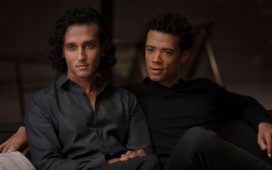One of the great modern documentaries is hiding in plain sight. “Who Killed Fourth Ward?,” directed by James Blue, from 1978, is available on YouTube, on a channel devoted to his work. It’s also part of a Blue retrospective at Metrograph, starting Friday, along with his most celebrated movie, the rarely screened and newly restored dramatic feature “The Olive Trees of Justice,” from 1962. That feature is vital, but “Who Killed Fourth Ward?” is life-changing: it overturns long-standing and deep-rooted expectations about the practice and results of documentary filmmaking. What’s more, although “Who Killed Fourth Ward?” is in three parts, each about an hour long, it’s the quickest three hours I’ve seen on film in quite a while.
Filmed mainly from July through September, 1976, the film is centered on Houston’s oldest Black neighborhood, the Fourth Ward, which was settled by formerly enslaved people in the eighteen-sixties and officialized, through segregation laws, in the nineteen-twenties. At the time of filming, Houston was in the midst of a substantial expansion of its downtown business district—and the Fourth Ward, which was adjacent to a new set of high-rise office towers, was indeed dying. Its housing stock was deteriorating; landlords weren’t improving or maintaining the buildings that they rented to residents and local business owners. Instead, they demolished houses and stores in order to have bare land available to sell to developers. As a result, the neighborhood’s population had rapidly diminished to about seven thousand people. Many of the houses that remained were dilapidated and prone to demolition, and the most prominent Black church, Antioch Missionary Baptist Church—the heart of the Black community—was feeling pressure to sell to developers whose high-rises were already pressing close to it.
Blue, a white man in his mid-forties, was living in Houston and teaching film at Rice University in the mid-nineteen-seventies. As he drove past the neighborhood, he noticed that one side of the highway was part of the city’s gleaming downtown business district and the other side was a series of small run-down shops and houses, and—as he had a commission to make a film on a subject of his choice—he decided to investigate. To start, Blue and his crew—the camera operator Brian Huberman and the sound recordist Ed Hugetz, who are also white—show up in the Fourth Ward and, as seen in the film, begin their investigation by approaching residents in the street and questioning them about their neighborhood. (The movie was shot on the amateur format of Super 8, then the main medium for home movies.) The interviews lead Blue to a much wider investigation, in terms of both his subject and his method.
From the start, Blue, Huberman, and Hugetz are seen and heard in the film interacting with interview subjects. Along with Blue’s physical presence in the film, he’s also a near-constant disembodied one, in the form of his own voice-over, created in the editing room retrospectively. This commentary adds to the film not exactly a stream of consciousness but, rather, an account of consciousness. He speaks of his motives in making the film and his apprehensions about it. He recalls his thought processes as he filmed particular sequences. He retrospectively considers how the onscreen events appear to him at the remove of a year or more (the movie was completed in 1978). Above all, he questions his own intentions, practices, and results, turning the film into a self-interrogation that asserts its own—and his own—inadequacy to the significant and complex matter at hand.
Blue quickly became aware that he was in a position to offer the poor residents of Fourth Ward their only chance to be heard publicly. But he also saw himself and his crew as “three white jerks with a camera parachuting in for ten minutes asking for the truth in twenty seconds and then dashing back to their middle-class neighborhoods.” He wondered, “Why wouldn’t they put us on?” Yet it seems that the residents speak candidly with him, and as he discovers the appalling conditions in which many Fourth Ward residents are forced to live—because landlords, awaiting the demolition of the houses that they own, refuse to pay for their upkeep—he realizes that it’s not enough simply to show what’s happening to the Black residents of Fourth Ward. He decides to investigate why it’s happening to them—and who’s making the decisions leading to the neighborhood’s elimination.
Blue meets with Tom Wright, a Black journalist who had been reporting on the plight of the Fourth Ward. Wright believes that the ongoing elimination of the Black community in the Fourth Ward is the result of a “conspiracy” among city officials, business interests, and landlords. Blue is shocked—the charge is too vast to make casually, and so he shifts the movie toward an in-depth consideration of it. Wright becomes a near-constant presence in the film, Blue’s Virgil: not just his guide into the Fourth Ward but into the city’s institutions of business and government, and, as a journalist, the film’s frontline interviewer.
The filmmakers gain remarkable access to government officials (including Houston’s mayor at the time, Fred Hofheinz, whom Wright also persuades to appear at a meeting with Fourth Ward residents), business leaders, real-estate developers, and local landlords. The extended and incisive questioning of these representatives of power and moneyed interests yields copious answers, but those answers prove, in their generous fullness, nonetheless evasive. It becomes clear that past decisions (such as the placement of the freeway) led to the circumstances at hand—even Hofheinz and other officials admit as much—but now, it seems, they have become irreversible and their results inevitable. (For instance, Houston had no zoning laws, and therefore officials asserted that they couldn’t dictate the use of any land at all, whether for residences or for business.)
The mystery behind the so-called natural economic forces that the city fathers blandly blame for the dispersal of the Fourth Ward’s Black residents doesn’t go unchallenged by Blue and his associates, but it eludes the filmmakers’ grasp. Blue had no subpoena power, no access to documents or backroom discussions. In effect, he was filming a phenomenon that was everywhere and nowhere, out in the open yet completely concealed, clamorous yet silent. He was making a film about white supremacy in the post-Jim Crow era—about the replacement of overt discrimination and enforced segregation with systemic racism.
There’s a hinge in the center of the movie—just about in the middle of Part 2—when Blue interviews Hazel Young, a parishioner of Antioch. She sees the church as an affirmation: “Here I am, as a Black person. . . . This is Black history itself. That was one of the things that Black people wanted people to know: that we are here, we were here, and we are still here.” It’s this declaration of existence, presence, and dignity that she considers to be under assault by the ongoing encroachment of developers with no pushback from government: “We’ve got that kind of feeling, that anything we have can be taken away from us because we’re Black.”
The essential fact of most documentaries is that filmmakers show up places where they don’t usually go, in pursuit of a story, and present those stories as if they themselves hadn’t actually been there discovering—or, rather, creating—them. The invisibility of filmmakers in supposedly “observational” documentaries is a fiction that veers toward a lie. What may be intended as the quest for an objective report, or as a self-effacing emphasis on the experience of the film’s subjects, frequently comes off as a mere façade. The paradox of so-called cinéma vérité is the ease with which its ostensibly objective and unmanipulated observation curdles, turning into cinéma fausseté, a falsification of the filmmakers’—and the subjects’—experience of the production of the film, of the realization of the moments and events that the documentary shows.







